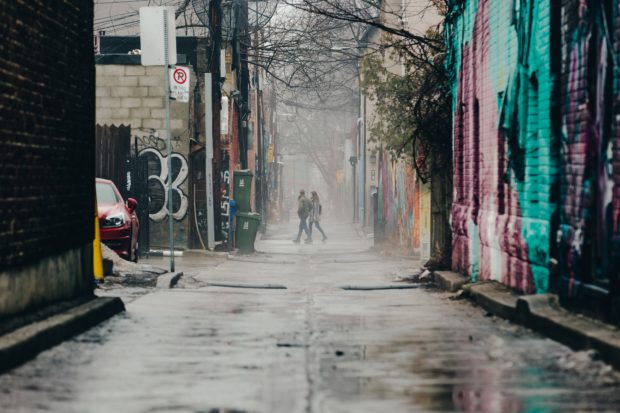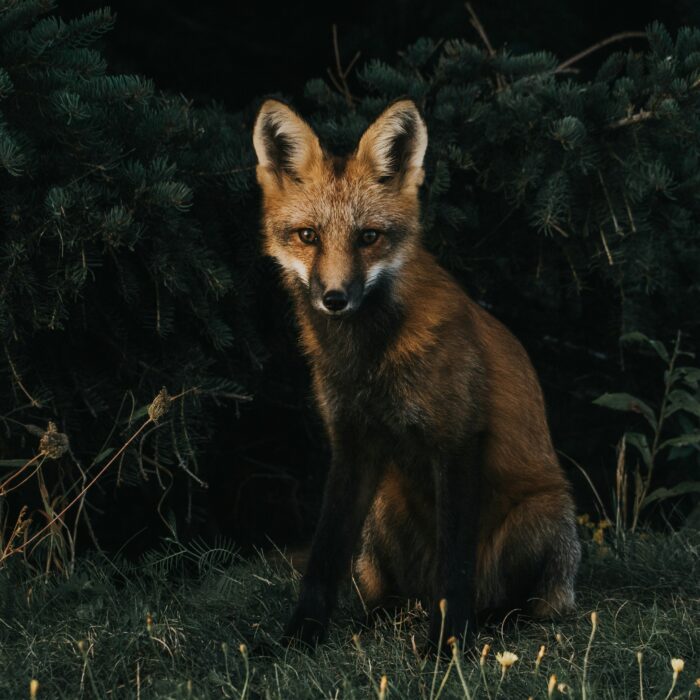You have no items in your cart. Want to get some nice things?
Go shopping
6:30 in the morning and the city is just waking up when I glance out the cracked kitchen window of my tiny apartment and see something unexpected yet familiar in the shadows of the unfinished apartment block across the alley.
Setting a cold glass of OJ down in the only clear spot on the coffee table I rummage through my backpack and draw out a pair of binoculars. I’m convinced they’re the kind of thing a reporter should carry.
Opening the balcony window releases a gentle rush of sea air that edges me closer to wakefulness. Binoculars raised to my eyes, I can’t help but smile. Out there amidst the red steel and grey concrete, seven floors up, is a graffiti tag. Six feet tall and twice as wide, spelled out in an explosion of greens and pinks is the word “DUKE”.
The wild-style writing would be incomprehensible to the casual observer, but typography is the graff writer’s obsession and a decade ago I was king of the docks. Back then I sometimes ran in a crew with DUKE.
People tend to assume graff writers are guys, and she chose a name that played into that. Sitting on a cold stone wall one night, sharing a joint and looking out over the million tiny lights that illuminated our playground, she told me about her dad. She said he was an old school authoritarian Catholic, basically a janitor for the church, and a big fan of John Wayne. She’d developed a hatred of Wayne by association and thought it funny to illegally plaster his moniker all over town.
Something’s nagging at me. Maybe the job already made me paranoid, seeking out stories where there are none, but I don’t think so. I’ve been out of the scene a while, but I was a tagger for years and it’s that cluster of neurons that are firing, shooting impulses to the part of my brain more recently developed and demanding to meet up for a chat.
A few minutes later I’m making my way up the cold concrete steps in the shell of the building, feeling a shadow of the excitement I used to live on. I’m somewhere I shouldn’t be, enveloped in the sounds and smells of the city. This is what graff is about, making a physical connection, anchoring yourself to the bricks and mortar, steel and glass of a city that otherwise doesn’t feel like it needs you.
My instinct is right, the tag is wrong. It’s close but I know DUKE’s handstyle as well as my own and this lacks her fluidity. Lines are joined up when they should be a seamless flow. Outlines bulged unevenly showing a lack of control. Copying is a big no, no in the community. I’d fired off a text to DUKE on the way out, but it came back unsent, number no longer in use.
*
An hour later I’m snaking through the traffic on my scooter, passing an urban gallery of steel shutters covered top to bottom in graffiti. This is the new norm in the city. After several high-profile pieces of politicized street art had appeared the authorities took a hard stance on all graffiti and it was “rubbed out” as quickly as it was put up. But the graff had been a tourist draw for decades with some operators even running graffiti tours. A compromise was reached called The Shutter Initiative. Hundreds of small shop owners gave permission for graff artists to use their shutters as canvases. Any unauthorized graff, or political street art anywhere, would be subject to immediate erasure. This makes the DUKE tag particularly odd. Regardless of its execution it took time and effort to produce but will be gone as soon as the site workers or authorities spot it.
I park outside Graff-Land. The shutters won’t be up for another hour but it’s the owner, Herman, that I need, and he lives above the store. I press his button on the intercom and announce myself. A moment later a window opens above, and Herm’s long face squints down at me. Herm was born old but now his face looks like a worn brown Converse.
“Holy shit, the prodigal returns. What brings you to my window? Call of the wild got too strong for ya?” says Herman.
“Not yet. Need to track down someone from back in the day, and seeing as you know everyone who ever put paint to wall…”
“Gimmie a sec.”
Herm opens the door in black combats, and a faded Nirvana shirt. Rather than inviting me in he steps out and rolls up the shutters.
“Had to start selling drinks and shit. Don’t sell enough paint to keep it runnin’. I’m usually open by now but I hit dismiss instead of snooze. Good thing you knocked.”
Inside, the long counter has been shortened to make room at the front for a pair of fake brown leather sofas and a coffee table. On the counter there’d been a wire rack stocked with sketchbooks and blank stickers, now there’s a food cabinet. There are still the racks of cans, but not as many as I remember. Herm clicks on the TV and fires up the coffee machine. Two kids walk in, bags on their shoulders. One is chowing down on a pizza slice. They drop into adjacent sofas with a familiarity that tells me they spend most of their free time here.
“Hey, you can’t be eating food from some other place in here,” says Herm
“Then you need to get your ass outa bed on time,” says pizza boy.
Herm rolls his eyes and shrugs before turning his attention back to the coffee machine.
“I don’t get it. With the Shutter Initiative making it less risky I figured there’d be more people doing it than ever,” I say.
“Without the risk it’s just painting. When you tagged that crane at the dock you were a legend. Think the Shutter Initiative is creating any legends? Most of that metal hasn’t seen new graff in a year.” I find this depressing, but it makes sense.
“So, who you looking for?”
“DUKE. Her tag appeared on a construction site next to my flat last night, but it wasn’t her that did it.”
“Huh. Brother, I haven’t seen DUKE in years. She drifted away from the scene not long after you quit. Maybe she’s back though, just a little rusty.”
“DUKE’s a guy,” says pizza boy’s companion. He’s turning a sketchbook this way and that as his marker skitters across the page.
“What do you know about DUKE?” I say. “You were still in nursery when she was around.”
“We were doing our thing a fortnight back and saw a kid coming out of this lockup. Had a drawstring on his back bulging with cans, guy practically rattled when he walked. We broke in once he’d cleared out, DUKE was tagged all over those walls.”
“You get a good look at him?” says Herm
“Nah, just saw him from the side, and he had his hood up, you know. Throw us forty and we’ll show you the place though.”
“You’re mistaking older for wealthier,” I say. “Give you twenty for the address?”
*
I make it to the paper on time, where between coffee runs and digging out archive photos for the sports section, I manage to get a few minutes with Stephanie Toza, the Arts and Culture reporter. I want to know if there’s any graff-related stories coming down the pipe and she wants to know why a lowly intern wants to know. What I get is that the Shutter Initiative is coming up for review in a fortnight. Grudgingly she gives up the name and contact details of the person that proposed and now oversees the initiative. I don’t see how it could have anything to do with the mystery tagger, but I promise to share anything I find with Toza in exchange for a byline.
The name I get is Mary Spinoza. Toza says she’s a local artist of some success, and she runs art classes for underprivileged teens at the Tapies Memorial Centre. I give them a call to confirm she’s there before heading over in my break.
*
Standing in the corridor looking through the big glass windows of the classroom I see DUKE for the second time today, only this time she’s standing there in the flesh, passing from student to student pointing out things that’re good, things that need work, always smiling. I catch my reflection in the glass and force the dopey puppy dog grin from my face. I could never be cool around DUKE.
*
“Oh my god, look at you,” says Mary, hugging me tightly.
“You haven’t changed. Can still smell the weed in your hoody,” I say, holding the embrace a fraction too long.
“Yeah well, I’m an artist, it’s expected.”
“I heard. How’s your dad feel about all this?”
“Dad never had a problem with the art, he’s still got a bunch of my old sketchbooks at home. He just thinks it should be indoors, not on doors. Anyway, what are you doing?”
“Interning at the Herald, which is kinda why I’m here.”
I pull out my phone and swipe to a photograph of her tag.
“Took this from my balcony this morning. Posted it up on social and there’ve been a half dozen other sighting over the city, all scrubbed now.”
“Shit. That’s not me, I haven’t done that for years.”
“I figured. It’s a little sloppy. Any idea who it could be?” Mary is pacing now, pirouetting on the heels of her Docs. I remember those same Docs putting down some asshole that was getting handsy with her one night at the beach.
“Any one of a dozen suits on the council. The Shutter Initiative scraped through the first time around. It’s up for review soon.”
“You think this could scupper it?”
“If they can connect it to me. It was my idea. If there’s any suggestion that I’m flouting the rules myself…”
We exchange number and arrange to meet up later. I hold off telling her about the lockup. I have an idea what’s going on but need to get back to the office and make some calls.
*
DUKE’s father has moved up the ranks since the old days and is now in charge of maintaining the church buildings across the whole diocese. I manage to arrange an interview with him, tell him we were doing a series of opinion pieces on graffiti in the runup to the Shutter Initiatives review. He’s keen to take part.
I’ve never been religious but in this city the church is inescapable, so I spent the Sunday mornings of my childhood squirming on a hard-wooden bench as the man behind the lectern droned on. It hadn’t occurred to me till now that those Sundays may have planted the seed for my tagging escapades. The only thing I liked about church were those big stained-glass windows. A light in the darkness, a towering block of color against the ancient stone. Perhaps it wasn’t just me, perhaps El Pez, Btoy, Miss Van, had all gotten the spark while sitting in the pews, tracing the lines of lead in those great glass throwups. Looking up at one now, through the crossbars of a scaffold tower it seems obvious.
Up top, is DUKE’s dad, Anthony.
“Mr. Spinoza? It’s Paul, from the Herald”
*
Ten minutes later we’re sitting outside a café opposite the church, in a box canyon made of apartment buildings. Anthony Spinoza looks older than the buildings he cares for.
“It’s just sad,” he says, spreading his arms to encompass the plaza. At street level the apartment blocks give way to shops and cafes, the former now closed for the day. A ring of painted shutters encircles the church.
“If they painted on the church it would be gone by midday, but we’re ten meters away and they can do as they please. Makes me sick.”
“Not a fan then?”
“If it’s art then they should be treated like artists. They display in a gallery. If they can afford paint, they can afford canvas.” There’s a tremor in his espresso.
“If it isn’t art then what are we doing letting them paint at all. This is a city of culture and we’re encouraging them to paint over it like, like … it’s shit.” He slams his fist down on the cast iron table, making the little basket of condiments jump and clatter. He stares at it, too embarrassed by his outburst to look at me.
“I agree with some of what you’re saying, but it’s not your decision to make and I’m not gonna let you throw your daughter under the bus to stop it.” That gets his attention. I toss a couple of photographs down, the tag from this morning, and the lock up. His shoulders sag, no denial.
“I don’t know who you paid to paint Mary’s tag all over town, but they used that lockup to practice. It’s owned by the diocese, storage space for when one of the church’s properties is undergoing major work, which makes you one of the few people with access to it. I spoke to Mary this afternoon, she mentioned that you had a bunch of her old sketchbooks. Her tag must be all over those, that’s where he copied it from right?”
“Are you going to tell her?” Even tone, eyes back on the basket.
“Not if it stops, and you don’t tip off the review board. I assume that was the plan. It’s dying out anyway, look at them.” Herm was right. The paint on the shutters is old, faded. My shoulders sag as well, and for a moment I feel closer to the old man across the table than the boy who used to skulk around the docks with a bag full of cans.
*
At home I message Mary that I won’t make it, but that she needn’t worry about the tagger, then I switch off my phone. Back on my balcony I look out over the building sight. The tag’s gone. I wonder if Toza will be pissed that I don’t have a story for her, so I fire up my laptop and open a new document.
Graffiti (The Writings on the Wall)

Martin Lymer
Martin Lymer lives in the UK, and is currently studying for a degree in English Literature and Creative Writing. When he's not doing this he can be found in a small cold room at the back of the house painting plastic soldiers for a living.




